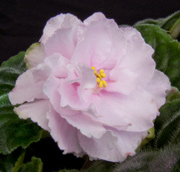It is often thought that there must be techniques in growing African violets of which only those in the know are aware, and able to employ.
Not so. Nothing is secret in our Association, and we are always happy to assist other growers.
However, here are some key tips, attention to which will help in producing happy, healthy, flowering plants.

Nancy Leigh
This is crucial in producing plants that will flower heavily. African violets need the following:
*
Ten to twelve hours of light each day
*
Light that is bright enough to cast a sharp shadow
*
No direct sun, except a little in winter, or early in the morning
*
A position within 450 mm (eighteen inches) of a window
*
Beware overhanging awnings, opposite buildings, large trees and dirty windows (all may block the light)
*
Alternatively, artificial (fluorescent or LED) light, 250—300 mm above the plants, for 10 to 12 hours each day
It is possible to solve all watering problems by using this system. It prevents the plants becoming too wet or too dry, and especially avoids the dry-wet cycle that is especially damaging to African violets.
This technique uses a wick, or cord, to draw water into the pot from a reservoir below the plant. Basically the pot should be out of the water and the wick should be hanging in the water. The wick material should be acrylic, nylon or similar (natural fibres will rot) and of an open weave that will transmit water. The wick should make good contact with the potting mix, extending around 20 mm into the pot. The wick and the potting mix should be moist to start the capillary action that carries the water up to the plant. An open and friable potting mix is essential for this easy way of watering to be a success
A reasonably good size reservoir, holding about a cup of water, can last an African violet for more than a week, even in summer, and perhaps much longer in winter. When away from home a larger reservoir will keep African violets smiling and continuing to flower even when their grower is away from home on holidays.
While African violets may be grown in many different kinds of media, results will be maximised if attention is paid to the following points. If wick watering, it is doubly important that this kind of potting mix is used, as it is this which allows the technique to be effective.
Potting mix should be:
*
Light, open and well drained
*
The major component of the mix should be air
*
Retentive of water and nutrients so that roots never dry out
*
Of neutral or slightly acid pH (neither strongly acid or alkaline)
*
Free of unwanted salts that may harm the plants
*
Clean and free of pathogens and weed seeds (possibly pasteurised)
*
Uncompacted, and if possible, relatively unable to be compacted
If attention to these matters still doesn’t give you the plants you want, then perhaps the missing ingredient is YOU. Success at anything, particularly live, growing things, does depend on constant attention. Fortunately wick-grown African violets survive and even thrive on minimal care, but they do need some regular attention.
This article appeared in the November 2006 edition of the Central Coast African Violet Club’s Newsletter, and more recently on that Club's website. Following the disbandment of the Central Coast African Violet Club in 2010 the article is now available here, with permission, for your information.